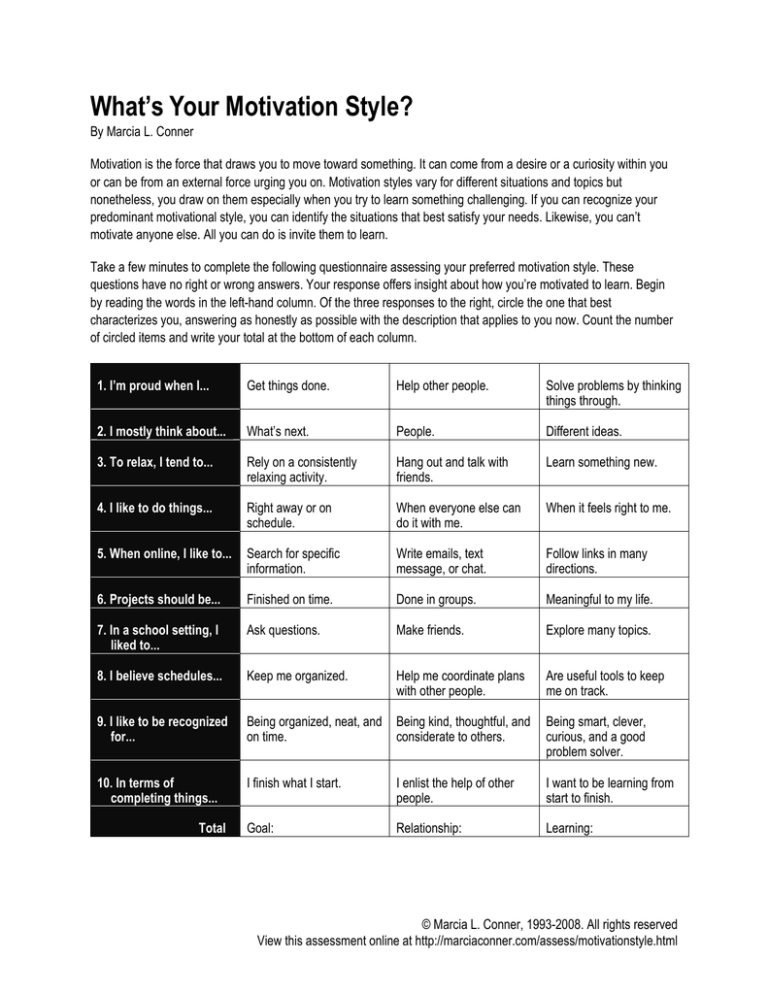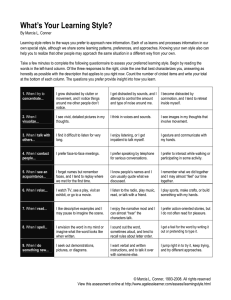
What’s Your Motivation Style?
By Marcia L. Conner
Motivation is the force that draws you to move toward something. It can come from a desire or a curiosity within you
or can be from an external force urging you on. Motivation styles vary for different situations and topics but
nonetheless, you draw on them especially when you try to learn something challenging. If you can recognize your
predominant motivational style, you can identify the situations that best satisfy your needs. Likewise, you can’t
motivate anyone else. All you can do is invite them to learn.
Take a few minutes to complete the following questionnaire assessing your preferred motivation style. These
questions have no right or wrong answers. Your response offers insight about how you’re motivated to learn. Begin
by reading the words in the left-hand column. Of the three responses to the right, circle the one that best
characterizes you, answering as honestly as possible with the description that applies to you now. Count the number
of circled items and write your total at the bottom of each column.
1. I’m proud when I...
Get things done.
Help other people.
Solve problems by thinking
things through.
2. I mostly think about...
What’s next.
People.
Different ideas.
3. To relax, I tend to...
Rely on a consistently
relaxing activity.
Hang out and talk with
friends.
Learn something new.
4. I like to do things...
Right away or on
schedule.
When everyone else can
do it with me.
When it feels right to me.
5. When online, I like to...
Search for specific
information.
Write emails, text
message, or chat.
Follow links in many
directions.
6. Projects should be...
Finished on time.
Done in groups.
Meaningful to my life.
7. In a school setting, I
liked to...
Ask questions.
Make friends.
Explore many topics.
8. I believe schedules...
Keep me organized.
Help me coordinate plans
with other people.
Are useful tools to keep
me on track.
9. I like to be recognized
for...
Being organized, neat, and
on time.
Being kind, thoughtful, and
considerate to others.
Being smart, clever,
curious, and a good
problem solver.
10. In terms of
completing things...
I finish what I start.
I enlist the help of other
people.
I want to be learning from
start to finish.
Goal:
Relationship:
Learning:
Total
© Marcia L. Conner, 1993-2008. All rights reserved
View this assessment online at http://marciaconner.com/assess/motivationstyle.html
The column with the highest total represents your primary motivation style. The column with the second-highest total
is your secondary motivation style.
Your primary motivation style:
Your secondary motivation style:
If you are goal-oriented, you probably reach for your goals through a direct and obvious route. This might lead you
to a reference book, your computer, or to call an expert—whatever means is available. You usually prefer meeting inperson when it’s the most effective method and don’t find learning, itself, much fun.
If you are relationship-oriented, you take part in learning mainly for social contact. When you meet and interact with
people, you learn things along the way. You may not like working independently or focusing on topics (separately
from the people) because that doesn’t give you the interactivity you crave.
If you are learning-oriented, the practice of learning, itself, drives you. You search for knowledge because learning
delights you and you may become frustrated by anything that requires you to spend more time following procedures
than on actual learning.
There is also a fourth motivation style I haven’t yet addressed, primarily because it’s far less common than the other
three styles and because you might not think of it as a motivation style at all. That style is thrill-oriented, drawn not
to any particular thing but, rather, away from anything that people perceive as tying them down, bounding them, or
pulling them in any predictable direction. This isn’t to say that thrill-oriented learners can’t acquire goals,
relationships, or curiosity, but if any of these feel too time-consuming, invasive, or binding, the learner becomes
restless and perhaps experiences a compulsion to go in another direction—any other direction—to feel free. If you’re
thrill-oriented, you’re likely to be impulsive and you want to remain impulsive; you seek thrills and flee anything that
doesn’t offer you that sensation. All of us at one time or another feel impulsive or have an urge to do something else,
but we usually moderate these urges when they come, instead of always following where they lead.
More information on each style, along with suggestions on how to maximize your motivation, is available in
the book Learn More Now (Hoboken, NJ; John Wiley & Sons, 2004).
A previous version of this assessment was published in Learn More Now: 10 Simple Steps to Learning Better, Smarter, and Faster (Hoboken,
NJ; John Wiley & Sons, March 2004). Learn about the book and read an excerpt at http://www.marciaconner.com/learnmorenow/.
Join Marcia Conner's mailing list to receive information about issues related to assessments and learning across the lifespan at
http://www.agelesslearner.com/joinus.html.
If you are interested in reproducing this assessment for personal or organizational uses, please abide by the following terms of use. This
content may be distributed freely without the author’s permission provided that 1) the content, contact, and copyright notice remain intact, 2) the
URL to the online version appears on every page, 3) you do not charge any fee for its use, 4) you send a note about how, where, and when the
content will be used to copyright@marciaconner.com for tracking purposes. If you’re interested in using the materials in a commercial or for-fee
product, or on a web page, contact the author first to learn about additional guidelines.
MLC051808
© Marcia L. Conner, 1993-2008. All rights reserved
View this assessment online at http://marciaconner.com/assess/motivationstyle.html



